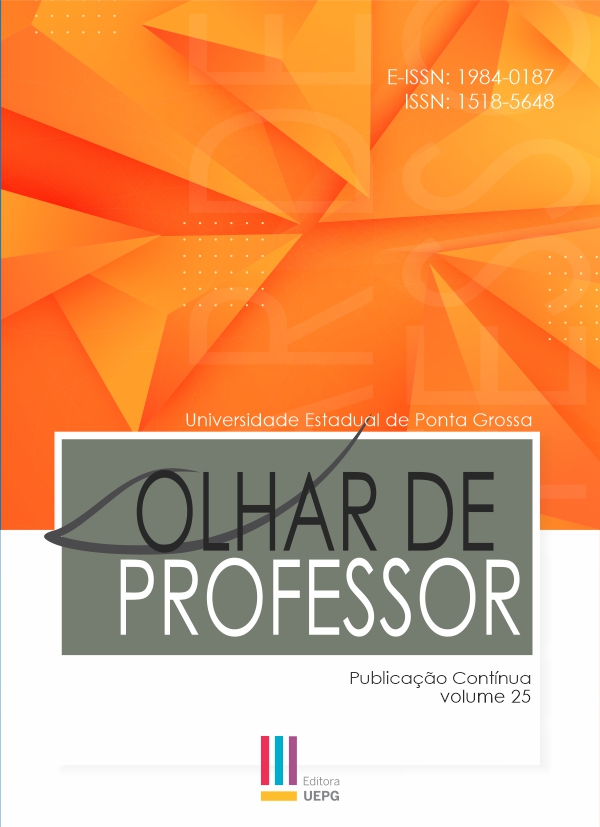The organization of play spaces in maternal II: an experience with thematic boxes
Main Article Content
Abstract
This study deals with the organization of play spaces in early childhood education. It aimed to create itinerant spaces for interactions and games for / with three-year-old children. The research-action type of research was carried out in a public school of early childhood education, in western Santa Catarina. It involved the participation of fifteen 3-year-olds in the construction of six thematic boxes. The theme of the boxes was chosen with the participating children: Box House, Beauty Salon Box, Tool Box, Nursery Box, Park Box and Surprise Box. The production of the data took place from the creation of wheels for planning the boxes and also during the organization and exploration of the play spaces by the children. The study showed that the Thematic Boxes are strategies for organizing spaces that enhance participation, interactions and games, promoting interdisciplinary learning in the early childhood school.
Downloads
Article Details
Authors who publish in this journal agree with the following terms:
a) Authors keep the copyrights and concede the right of its first publication to the magazine. The work piece must be simultaneously licensed on the Creative Commons Attribution License which allows the paper sharing, and preserves both the author identity and the right of first publication to this magazine.
b) Authors are authorized to assume additional contracts separately, to not-exclusively distribution of the paper version published in this magazine (e.g.: publish in institutional repository or as a book chapter), with the author identity recognition and its first publication in this magazine.
c) Authors are permitted and stimulated to publish and distribute their papers online (e.g.: in institutional repository or on their personal webpage), considering it can generate productive alterations, as well as increase the impact and the quotations of the published paper.
d) This journal provides public access to all its content, as this allows a greater visibility and reach of published articles and reviews. For more information on this approach, visit the Public Knowledge Project, a project that developed this system to improve the academic and public quality of the research, distributing OJS as well as other software to support the publication system of public access to academic sources.
e) The names and e-mail addresses on this site will be used exclusively for the purposes of the journal and are not available for other purposes.

This work is licensed under a Creative Commons Attribution 4.0 International License.
References
BARBOSA, M.C.S. Culturas escolares, culturas de infância e culturas familiares: as socializações e a escolarização no entretecer destas culturas. Educação e Sociedade, Campinas, v. 28, n. 100 (Especial), p. 1059-1083, out. 2007. DOI: https://doi.org/10.1590/S0101-73302007000300020
BARBOSA, M.C.S. Por amor e por força: rotinas na educação infantil. Porto Alegre: Artmed, 2006.
BRASIL. Estatuto da Criança e do Adolescente (ECA) – Lei nº. 8.069. Brasília, DF: Senado Federal, 1990. Disponível em: <http://www.planalto.gov.br/ccivil_03/Leis/L8069.htm>. Acesso em: 05 de novembro de 2019.
BRASIL. Ministério da Educação. Base Nacional Comum Curricular (BNCC). Brasília, DF: MEC/CNE, 2018. Disponível em: http://basenacionalcomum.mec.gov.br/images/BNCC_EI_EF_110518_versaofinal_site.pdf. Acesso em: 2 ago. 2019.
BRASIL. Ministério da Educação. Secretaria de Educação Básica. Projeto de fortalecimento institucional das secretarias municipais de educação na formulação e implementação da política municipal de educação infantil. Conselho Nacional de Educação. Resolução n.º 5, de 17 de dezembro de 2009. Brasília, DF: MEC/SEB, 2013. Disponível em: http://paralapraca.org.br/wp-content/uploads/projeto_de_fortalecimento_institucional_das_secretarias_municipais_de_educacao_na_formulacao_e_implementacao_da_politica_municipal_de_educacao_infantil-30_01_2015.pdf. Acesso em: 20 ago. 2019.
BRASIL. Ministério da Educação. Brasília, DF: MEC/CNE, 2018. Disponível em: http://basenacionalcomum.mec.gov.br/images/BNCC_EI_EF_110518_versaofinal_site.pdf. Acesso em: 2 ago. 2019.
CORSARO, Willian A. Sociologia da infância. Porto Alegre: Artmed; 2011.
HORN, M. G. S. Brincar e interagir nos espaços da escola infantil. Porto Alegre: Penso, 2017.
HORN, M. G. S. Sabores, cores, sons, aromas: a organização dos espaços na educação infantil. Porto Alegre: Artmed, 2004.
MARQUES, C. M.; FERNANDES, S. B.; SILVA, E. T. O brincar nos discursos de estudantes de Pedagogia: certezas em suspenso. Campinas/SP: Pro- posições, v. 30, 2019. http://dx.doi.org/10.1590/1980-6248-2016-0136. DOI: https://doi.org/10.1590/1980-6248-2016-0136
MARQUES, C. M. Caixas de brincadeiras. Revista Pátio-Educação Infantil, Porto Alegre a. 5, n. 13, p. 32-33, mar./jun. 2007.
MEDEL, C. R. M. A. Educação infantil: da construção do ambiente às práticas pedagógicas. 2. ed. Petrópolis: Vozes, 2012.
OLIVEIRA, Z. M. R. Educação infantil: fundamentos e métodos. 7. ed. São Paulo: Cortez, 2011.
SOARES, N. F. A investigação participativa no grupo social da infância. Currículo sem Fronteiras, v. 6, n. 1, p. 25-40, jan./jun. 2006.





